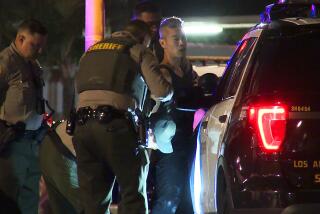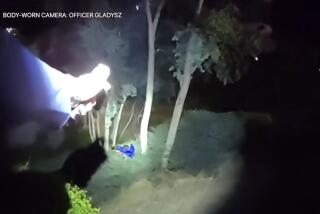Officer Named : Suit in Shooting of Escapee Goes to Trial Today
- Share via
An Anaheim patrolman and his department face trial today in a lawsuit filed by an escaped convict who was shot and left paralyzed from the waist down.
The 1981 shooting by Patrolman James Conley, 44, left Ronald E. Gibson confined to a wheelchair for life. Gibson lives alone in an isolated Nevada desert community, subsisting on $380 a month in disability benefits and food stamps, according to his lawyer, Christopher B. Mears.
Gibson has incurred $135,000 in medical expenses and can expect to spend $20,000 for medical help for the rest of his life, according to Mears. He filed a civil suit suit asking for $1 million in damages.
Self-Defense Assertion
Conley’s lawyer, Jeffrey M. Epstein, said his client did nothing wrong and was justified in using his weapon. Epstein, known for his aggressive defense of police officers, said he will show that Conley acted in self-defense.
Conley told investigators he shot Gibson after the escapee bent over as if to reach a weapon, but Gibson’s lawyer said his client wasn’t armed. Police were also told by witnesses that Gibson was running away from the officer when he was shot in the back, according to documents on file in the case.
According to those documents, Conley said he was told by an an informant that Gibson was in town and was wanted for escape. Gibson had escaped from the state prison in Chino the previous August, where he had been serving time for second-degree burglary.
Put Hands in Air
Conley spotted Gibson in a car in a parking lot in the 200 block of West Lincoln Avenue. He pulled up next to Gibson’s car, pulled out his handgun and ordered the escapee out of the car. Gibson, according to the court file, got out and put his hands in the air.
He “suddenly lowered his hands and bent over at the same time,” Conley told investigators.
“I believed that he was reaching for a weapon in his boot and that he was going to attempt to get to the rear of his car,” the officer said.
Epstein said Conley believed his life was in danger and was justified in shooting after Gibson made the move.
“The only problem with that is that Gibson was not armed,” countered Mears.
“Richard Gibson was not suicidal. Why would he go for a gun that’s not there?”
Jose M. Torres of Santa Ana told investigators he saw Gibson start to flee after he got out of the car.
“The big guy, you know, started running fast,” Torres said, according to a transcript on file in the case. “Then the policeman shot him right away.”
Torres said Conley then radioed for help and waited until fellow officers arrived before approaching Gibson. Torres said he saw Gibson face down on the pavement, handcuffed by police before paramedics arrived.
Due to complications from the paralysis, “his left leg was amputated four months ago,” Mears said. “He is incontinent, he has no bladder control, no sexual function. He’s an enforced recluse.”
The case will be tried before Orange County Superior Judge Richard N. Parslow Jr.
More to Read
Sign up for Essential California
The most important California stories and recommendations in your inbox every morning.
You may occasionally receive promotional content from the Los Angeles Times.









